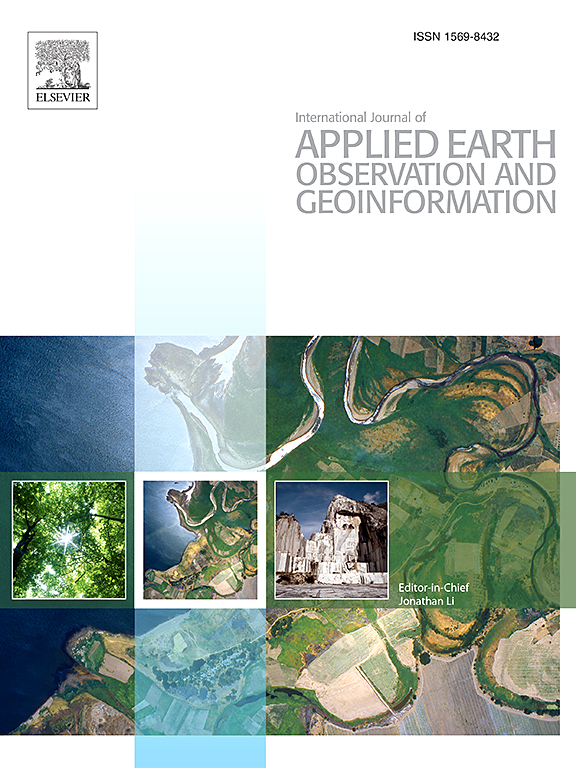Long short-term memory exploitation of satellite gravimetry to infer floods
IF 7.6
Q1 REMOTE SENSING
International journal of applied earth observation and geoinformation : ITC journal
Pub Date : 2025-05-01
DOI:10.1016/j.jag.2025.104562
引用次数: 0
Abstract
Flood forecasting is a vital segment of disaster risk management in that it contributes to the prediction of the magnitude, occurrence, duration and timing of floods. Owing to the nonlinear nature of atmospheric phenomena, however, forecasting becomes a challenging task that requires a multifaceted approach involving various sensors. Indeed, there exist compounding evidence that flood processes would benefit from use of various sensors. One such sensor is the Gravity Recovery and Climate Experiment (GRACE) and its follow-on (GRACE-FO), which provides Total Water Storage (TWS) products that could potentially be useful for flood monitoring and forecasting. However, GRACE/GRACE-FO’s coarse spatial resolution of 300 km remains a bottleneck to the full exploitation of its products for flood studies and management. Herein, a deep learning Long Short-Term Memory (LSTM) method with high learning capability that optimizes the hyperparameters is proposed to downscale the coarse GRACE/GRACE-FO TWS products (from 300 km to 55 km). Its spatial and temporal learning is subjected to three different training scenarios (i.e., 60 %, 70 % and 85 %), where the one with least root-mean-square-errors (RMSE) is selected as the best-case scenario. The proposed LSTM deep learning approach is tested based on the 2019 Lorestan flood in Iran, where the results show that it successfully models the spatio-temporal behavior of TWS changes with its long-term and short-term memory capabilities. In March and April 2019, heavy precipitation caused a significant increase in TWS changes, approximately 40 ± 2 cm. This is captured by the LSTM-downscaled products but not the coarse GRACE/GRACE-FO TWS changes. Furthermore, the LSTM downscaled GRACE-FO TWS for the period after 2018 shows a strong and statistically significant mean correlation (above 0.70 at the 95 % confidence level) with both river discharge and precipitation. The original GRACE-FO on the other hand shows a correlation of 0.40, indicating the superiority of the LSTM-derived GRACE-FO’s TWS changes. The coarse resolution of the GRACE satellite is a major cause of low correlation, which improves after downscaling. LSTM thus has the potential of downscaling GRACE products, providing data that are useful for flood process, management and studies.
利用卫星重力长短期记忆法推断洪水
洪水预报是灾害风险管理的重要组成部分,它有助于预测洪水的规模、发生情况、持续时间和时间。然而,由于大气现象的非线性性质,预报成为一项具有挑战性的任务,需要涉及各种传感器的多方面方法。事实上,有综合证据表明,洪水过程将受益于使用各种传感器。其中一个传感器是重力恢复和气候实验(GRACE)及其后续(GRACE- fo),它提供的总蓄水量(TWS)产品可能对洪水监测和预报有用。然而,GRACE/GRACE- fo 300公里的粗空间分辨率仍然是其产品在洪水研究和管理中充分利用的瓶颈。为此,提出了一种具有高学习能力的深度学习长短期记忆(LSTM)方法,并对超参数进行了优化,将GRACE/GRACE- fo粗TWS产品从300 km降至55 km。它的空间和时间学习受到三种不同的训练场景(即60%,70%和85%)的影响,其中选择均方根误差(RMSE)最小的场景作为最佳情况。基于2019年伊朗Lorestan洪水对提出的LSTM深度学习方法进行了测试,结果表明,该方法成功地模拟了TWS变化的时空行为及其长期和短期记忆能力。2019年3月和4月,强降水导致TWS变化显著增加,约为40±2 cm。这是由lstm缩小的产品捕获的,而不是粗糙的GRACE/GRACE- fo TWS变化。此外,LSTM缩小了GRACE-FO TWS在2018年之后的时间尺度,显示出与河流流量和降水的强且统计显著的平均相关性(在95%置信水平上高于0.70)。另一方面,原始GRACE-FO的相关性为0.40,表明lstm推导的GRACE-FO的TWS变化具有优势。GRACE卫星的粗分辨率是导致相关性低的主要原因,降尺度后相关性有所改善。因此,LSTM有可能缩小GRACE产品的规模,为洪水过程、管理和研究提供有用的数据。
本文章由计算机程序翻译,如有差异,请以英文原文为准。
求助全文
约1分钟内获得全文
求助全文
来源期刊

International journal of applied earth observation and geoinformation : ITC journal
Global and Planetary Change, Management, Monitoring, Policy and Law, Earth-Surface Processes, Computers in Earth Sciences
CiteScore
12.00
自引率
0.00%
发文量
0
审稿时长
77 days
期刊介绍:
The International Journal of Applied Earth Observation and Geoinformation publishes original papers that utilize earth observation data for natural resource and environmental inventory and management. These data primarily originate from remote sensing platforms, including satellites and aircraft, supplemented by surface and subsurface measurements. Addressing natural resources such as forests, agricultural land, soils, and water, as well as environmental concerns like biodiversity, land degradation, and hazards, the journal explores conceptual and data-driven approaches. It covers geoinformation themes like capturing, databasing, visualization, interpretation, data quality, and spatial uncertainty.
 求助内容:
求助内容: 应助结果提醒方式:
应助结果提醒方式:


